- GCN/BACODINE POSITION NOTICE
TITLE: GCN/SWIFT NOTICE
NOTICE_DATE: Sat 08 Oct 05 16:44:57 UT
NOTICE_TYPE: Swift-BAT GRB Position
TRIGGER_NUM: 158855, Seg_Num: 0
GRB_RA: 202.870d {+13h 31m 29s} (J2000),
202.933d {+13h 31m 44s} (current),
202.327d {+13h 29m 18s} (1950)
GRB_DEC: +42.090d {+42d 05' 26"} (J2000),
+42.061d {+42d 03' 39"} (current),
+42.348d {+42d 20' 51"} (1950)
GRB_ERROR: 4.00 [arcmin radius, statistical only]
GRB_INTEN: 5111 [cnts] Image_Peak=220 [image_cnts]
TRIGGER_DUR: 1.024 [sec]
TRIGGER_INDEX: 148 E_range: 25-100 keV
BKG_INTEN: 30546 [cnts]
BKG_TIME: 59584.00 SOD {16:33:04.00} UT
BKG_DUR: 8 [sec]
GRB_DATE: 13651 TJD; 281 DOY; 05/10/08
GRB_TIME: 59601.31 SOD {16:33:21.31} UT
GRB_PHI: -28.68 [deg]
GRB_THETA: 44.02 [deg]
SOLN_STATUS: 0x3
RATE_SIGNIF: 17.14 [sigma]
IMAGE_SIGNIF: 9.65 [sigma]
MERIT_PARAMS: +1 +0 +0 +0 +2 +16 +0 +0 -65 +1
SUN_POSTN: 194.27d {+12h 57m 05s} -6.10d {-06d 05' 57"}
SUN_DIST: 48.80 [deg]
MOON_POSTN: 257.16d {+17h 08m 38s} -27.75d {-27d 45' 03"}
MOON_DIST: 85.86 [deg]
MOON_ILLUM: 28 [%]
GAL_COORDS: 96.83, 72.95 [deg] galactic lon,lat of the burst (or transient)
ECL_COORDS: 179.83, 46.86 [deg] ecliptic lon,lat of the burst (or transient)
COMMENTS: SWIFT-BAT GRB Coordinates.
COMMENTS: This is a rate trigger.
COMMENTS: A point_source was found.
COMMENTS: This does not match any source in the on-board catalog.
COMMENTS: This does not match any source in the ground catalog.
COMMENTS: This is a GRB.
- red DSS finding chart
ps-file
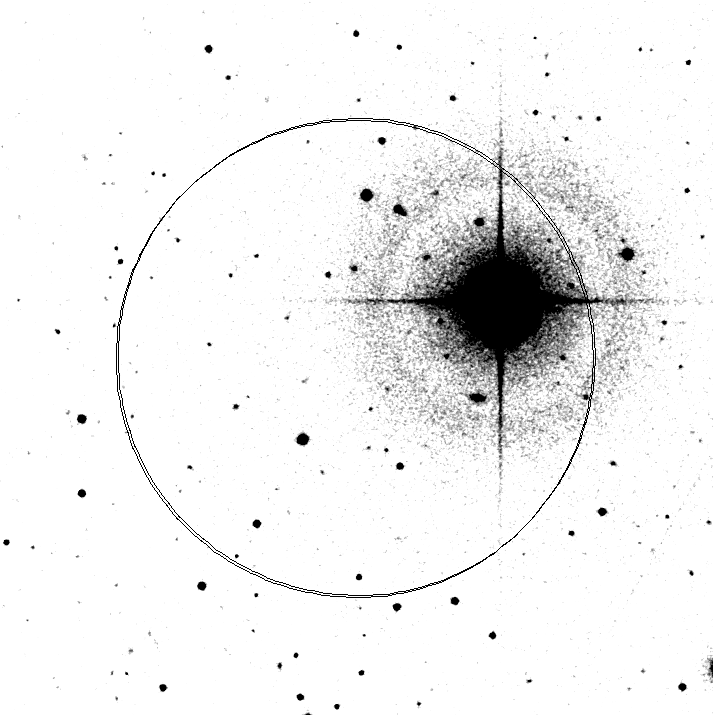
- GCN/SWIFT NOTICE
TITLE: GCN/SWIFT NOTICE
NOTICE_DATE: Sat 08 Oct 05 16:45:14 UT
NOTICE_TYPE: Swift-BAT GRB Lightcurve
TRIGGER_NUM: 158855, Seg_Num: 0
GRB_RA: 202.870d {+13h 31m 29s} (J2000),
202.933d {+13h 31m 44s} (current),
202.327d {+13h 29m 18s} (1950)
GRB_DEC: +42.090d {+42d 05' 26"} (J2000),
+42.061d {+42d 03' 39"} (current),
+42.348d {+42d 20' 51"} (1950)
GRB_DATE: 13651 TJD; 281 DOY; 05/10/08
GRB_TIME: 59601.31 SOD {16:33:21.31} UT
TRIGGER_INDEX: 148
GRB_PHI: -28.68 [deg]
GRB_THETA: 44.02 [deg]
DELTA_TIME: 51.00 [sec]
TRIGGER_DUR: 1.024 [sec]
LC_URL: sw00158855000msb.lc
SUN_POSTN: 194.27d {+12h 57m 05s} -6.10d {-06d 05' 57"}
SUN_DIST: 48.80 [deg]
MOON_POSTN: 257.16d {+17h 08m 38s} -27.75d {-27d 45' 03"}
MOON_DIST: 85.86 [deg]
MOON_ILLUM: 28 [%]
GAL_COORDS: 96.83, 72.95 [deg] galactic lon,lat of the pointing direction
ECL_COORDS: 179.83, 46.86 [deg] ecliptic lon,lat of the pointing direction
COMMENTS: SWIFT-BAT GRB Lightcurve.
COMMENTS:
COMMENTS: The next comments were copied from the BAT_POS Notice:
COMMENTS: This is a rate trigger.
COMMENTS: A point_source was found.
COMMENTS: This does not match any source in the on-board catalog.
COMMENTS: This does not match any source in the ground catalog.
COMMENTS: This is a GRB.
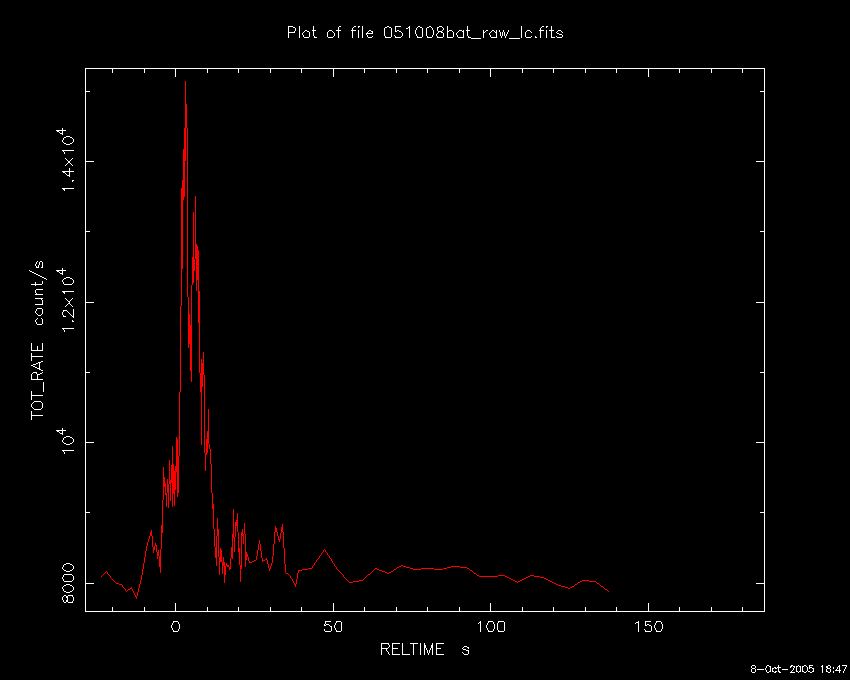
- GCN notice #4069
F. Marshall (GSFC), S. Barthelmy (GSFC), J. Cummings (GSFC/NRC),
J. Norris (GSFC), M. Perri (ASDC), T. Sakamoto (GSFC)
on behalf of the Swift team:
At 16:33:21 UT, Swift-BAT triggered and located GRB051008 (trigger=158855).
The spacecraft did not slew immediately because of the Earth observing
constraint. The burst will be observed by the NFIs at T+48 minutes
when it comes out of constraint. The BAT on-board calculated location
is RA,Dec 202.870d,+42.090d {13h 31m 29s,+42d 05' 26"} (J2000),
with an uncertainty of 3 arcmin (radius, 90% containment, stat+sys).
The BAT light curve shows two main overlapping peaks with a total duration
of ~30 sec. The peak count rate was ~7000 counts/sec (15-350 keV),
at ~4 seconds after the trigger. This burst happened during a Malindi
telemetry down link session, so the TDRSS burst-related notices were delayed
in transmission until the end of the downlink pass (~10 min).
- GCN/SWIFT NOTICE
TITLE: GCN/SWIFT NOTICE
NOTICE_DATE: Sat 08 Oct 05 17:24:00 UT
NOTICE_TYPE: Swift-XRT Nack-Position
TRIGGER_NUM: 158855, Seg_Num: 0
POINT_RA: 202.853d {+13h 31m 25s} (J2000)
POINT_DEC: +42.063d {+42d 03' 49"} (J2000)
GRB_DATE: 13651 TJD; 281 DOY; 05/10/08
GRB_TIME: 62631.85 SOD {17:23:51.85} UT
COUNTS: 6 Min_needed= 20
STD_DEV: 0.00 Max_StdDev_for_Good=28.44 [arcsec]
PH2_ITER: 1 Max_iter_allowed= 4
ERROR_CODE: 1
COMMENTS: SWIFT-XRT Nack Position.
COMMENTS: No source found in the image.
- GCN/SWIFT NOTICE
TITLE: GCN/SWIFT NOTICE
NOTICE_DATE: Sat 08 Oct 05 17:28:17 UT
NOTICE_TYPE: Swift-XRT Lightcurve
TRIGGER_NUM: 158855, Seg_Num: 0
POINT_RA: 202.850d {+13h 31m 24s} (J2000)
POINT_DEC: +42.064d {+42d 03' 51"} (J2000)
LC_START_DATE: 13651 TJD; 281 DOY; 05/10/08
LC_START_TIME: 62634.63 SOD {17:23:54.63} UT
LC_STOP_DATE: 13651 TJD; 281 DOY; 05/10/08
LC_STOP_TIME: 62885.28 SOD {17:28:05.28} UT
LC_LIVE_TIME: 247.02 [sec], 98.6%
DELTA_TIME: 86149.35 [sec]
N_BINS: 100
TERM_COND: 0
LC_URL: sw00158855000msx.lc
SUN_POSTN: 194.30d {+12h 57m 13s} -6.11d {-06d 06' 45"}
SUN_DIST: 48.78 [deg]
MOON_POSTN: 257.69d {+17h 10m 46s} -27.81d {-27d 48' 39"}
MOON_DIST: 86.19 [deg]
MOON_ILLUM: 28 [%]
GAL_COORDS: 96.83, 72.98 [deg] galactic lon,lat of the pointing direction
ECL_COORDS: 179.83, 46.83 [deg] ecliptic lon,lat of the pointing direction
COMMENTS: SWIFT-XRT Lightcurve.
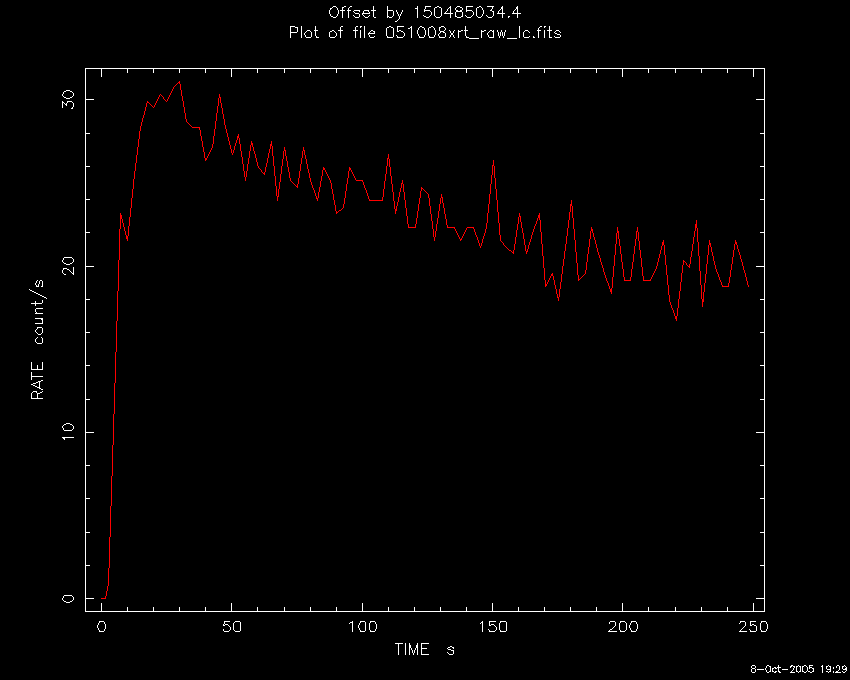
- GCN/SWIFT NOTICE
TITLE: GCN/SWIFT NOTICE
NOTICE_DATE: Sat 08 Oct 05 17:30:25 UT
NOTICE_TYPE: Swift-UVOT Source List
TRIGGER_NUM: 158855, Seg_Num: 0
POINT_RA: 202.853d {+13h 31m 25s} (J2000)
POINT_DEC: +42.064d {+42d 03' 49"} (J2000)
POINT_ROLL: 191.342d
GRB_DATE: 13651 TJD; 281 DOY; 05/10/08
GRB_TIME: 62629.60 SOD {17:23:49.60} UT
FILTER: 3, V
BKG_MEAN: 2.209
N_STARS: 190
X_OFFSET: 476 [pixels]
Y_OFFSET: 555 [pixels]
X_MAX: 1435 [pixels]
Y_MAX: 1514 [pixels]
DET_THRESH: 12
PHOTO_THRESH: 6
SL_URL: sw00158855000msufc.fits
SUN_POSTN: 194.30d {+12h 57m 13s} -6.11d {-06d 06' 45"}
SUN_DIST: 48.78 [deg]
MOON_POSTN: 257.69d {+17h 10m 46s} -27.81d {-27d 48' 39"}
MOON_DIST: 86.19 [deg]
MOON_ILLUM: 28 [%]
GAL_COORDS: 96.82, 72.98 [deg] galactic lon,lat of the pointing direction
ECL_COORDS: 179.84, 46.83 [deg] ecliptic lon,lat of the pointing direction
COMMENTS: SWIFT-UVOT Source List.
- GCN/SWIFT NOTICE
TITLE: GCN/SWIFT NOTICE
NOTICE_DATE: Sat 08 Oct 05 17:30:52 UT
NOTICE_TYPE: Swift-UVOT Processed Source List
TRIGGER_NUM: 158855, Seg_Num: 0
POINT_RA: 202.853d {+13h 31m 25s} (J2000)
POINT_DEC: +42.064d {+42d 03' 49"} (J2000)
POINT_ROLL: 191.342d
GRB_DATE: 13651 TJD; 281 DOY; 05/10/08
GRB_TIME: 62629.60 SOD {17:23:49.60} UT
FILTER: 3, V
BKG_MEAN: 2.209
N_STARS: 190
X_OFFSET: 476 [pixels]
Y_OFFSET: 555 [pixels]
X_MAX: 1435 [pixels]
Y_MAX: 1514 [pixels]
DET_THRESH: 12
PHOTO_THRESH: 6
SL_URL: sw00158855000msufc.fits
SUN_POSTN: 194.30d {+12h 57m 13s} -6.11d {-06d 06' 45"}
SUN_DIST: 48.78 [deg]
MOON_POSTN: 257.69d {+17h 10m 46s} -27.81d {-27d 48' 39"}
MOON_DIST: 86.19 [deg]
MOON_ILLUM: 28 [%]
GAL_COORDS: 96.82, 72.98 [deg] galactic lon,lat of the pointing direction
ECL_COORDS: 179.84, 46.83 [deg] ecliptic lon,lat of the pointing direction
COMMENTS: SWIFT-UVOT Processed Source List.
COMMENTS: All 4 attachments are included.
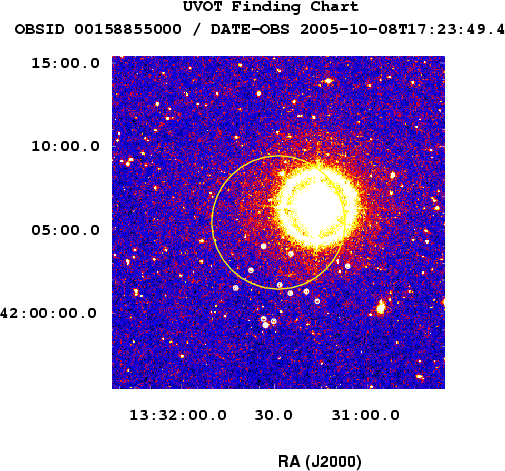
- GCN/SWIFT NOTICE
TITLE: GCN/SWIFT NOTICE
NOTICE_DATE: Sat 08 Oct 05 17:31:47 UT
NOTICE_TYPE: Swift-UVOT Image
TRIGGER_NUM: 158855, Seg_Num: 0
POINT_RA: 202.853d {+13h 31m 25s} (J2000)
POINT_DEC: +42.064d {+42d 03' 49"} (J2000)
ROLL: 191.342d
GRB_DATE: 13651 TJD; 281 DOY; 05/10/08
GRB_TIME: 62629.60 SOD {17:23:49.60} UT
FILTER: 3, V
EXPOSURE_ID: 150485029
X_OFFSET: 795 [pixels]
Y_OFFSET: 874 [pixels]
WIDTH: 160 [pixels]
HEIGHT: 160 [pixels]
X_GRB_POS: 955
Y_GRB_POS: 1034
BINNING_INDEX: 1
IM_URL: sw00158855000msuni.fits
SUN_POSTN: 194.30d {+12h 57m 13s} -6.11d {-06d 06' 45"}
SUN_DIST: 48.78 [deg]
MOON_POSTN: 257.69d {+17h 10m 46s} -27.81d {-27d 48' 39"}
MOON_DIST: 86.19 [deg]
MOON_ILLUM: 28 [%]
GAL_COORDS: 96.82, 72.98 [deg] galactic lon,lat of the pointing direction
ECL_COORDS: 179.84, 46.83 [deg] ecliptic lon,lat of the pointing direction
COMMENTS: SWIFT-UVOT Image.
COMMENTS: The GRB Position came from the Window Position in the Mode Command.
COMMENTS: The image has 2x2 binning (compression).
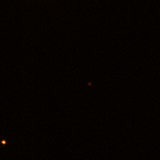
- GCN/SWIFT NOTICE
TITLE: GCN/SWIFT NOTICE
NOTICE_DATE: Sat 08 Oct 05 17:32:21 UT
NOTICE_TYPE: Swift-UVOT Processed Image
TRIGGER_NUM: 158855, Seg_Num: 0
POINT_RA: 202.853d {+13h 31m 25s} (J2000)
POINT_DEC: +42.064d {+42d 03' 49"} (J2000)
ROLL: 191.342d
GRB_DATE: 13651 TJD; 281 DOY; 05/10/08
GRB_TIME: 62629.60 SOD {17:23:49.60} UT
FILTER: 3, V
EXPOSURE_ID: 150485029
X_OFFSET: 795 [pixels]
Y_OFFSET: 874 [pixels]
WIDTH: 160 [pixels]
HEIGHT: 160 [pixels]
X_GRB_POS: 955
Y_GRB_POS: 1034
BINNING_INDEX: 1
IM_URL: sw00158855000msuni.fits
SUN_POSTN: 194.30d {+12h 57m 13s} -6.11d {-06d 06' 45"}
SUN_DIST: 48.78 [deg]
MOON_POSTN: 257.69d {+17h 10m 46s} -27.81d {-27d 48' 39"}
MOON_DIST: 86.19 [deg]
MOON_ILLUM: 28 [%]
GAL_COORDS: 96.82, 72.98 [deg] galactic lon,lat of the pointing direction
ECL_COORDS: 179.84, 46.83 [deg] ecliptic lon,lat of the pointing direction
COMMENTS: SWIFT-UVOT Processed Image.
COMMENTS: If you have elected to receive attachments:
COMMENTS: The uvot_catalog_image.fits.gz file does not exist; skipping the attachment.
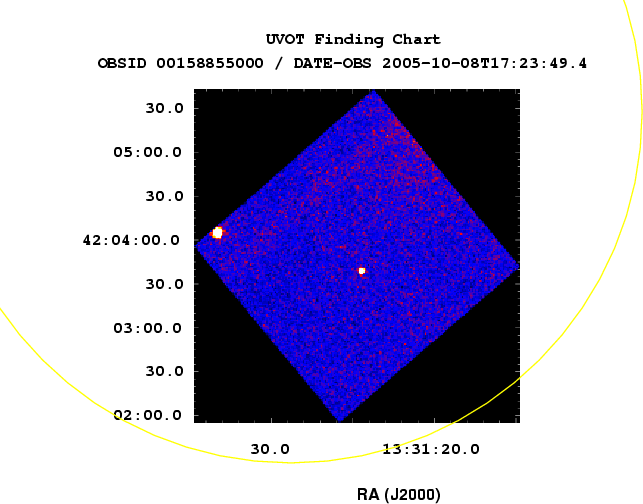
- GCN notice #4070
P. Roming (PSU), F. Marshall (GSFC), A. Blustin (MSSL) on behalf of the Swift
UVOT team:
The UVOT began observing GRB 051008 at 17:23:49 UT, 3028 s after the BAT
trigger. In the on board processing of the 200 s V-band image, UVOT detected a
possible candidate afterglow with respect to the DSS at the following
coordinates:
RA: 13:31:28.1
Dec: +42:08:05
We estimate the error to be a 1 arcsec radius. The preliminary magnitude
estimation is ~15 mag. The source is located in the initial BAT error circle.
Analysis on the full field image on the ground is required to verify the
authenticity of this source.
- GCN notice #4071
M. Perri, M. Capalbi (ASDC), D.N. Burrows (PSU) report on behalf of the
Swift XRT team:
XRT began observing the field at 17:23:52 UT, about 50 minutes after the
BAT trigger. The on-board centroiding algorithm did not converge on a
source, so no prompt X-ray position is available.
However, the downlinked lightcurve shows evidence for a fading X-ray
source in the field of view. There are no catalogued X-ray sources in
the field, indicating that this source is the GRB afterglow.
Further analysis will require processing of the XRT full telemetry data
following the next ground station contact.
- GCN notice #4072
S. Klose and C. Hoegner, Thueringer Landessternwarte Tautenburg
report:
We observed the error circle of GRB 051008 with the Tautenburg
Schmidt telescope. I-band observations started 17:31 UT, i.e.
1 hr after the burst. R-band observations followed at 17:57 UT.
A first inspection of the images does not reveal an afterglow
candidate, neither in the R band nor in the I band down to the DSS2
red limit. A bright star in the field affects the observations a bit
but we exclude a bright afterglow as close as 20 arcsec to this star.
The bright afterglow candidate reported by Roming et al. (GCN 4070) is
visible on our images, of course. Even though, this source is also visible
on the DSS2-red so that its identification as the afterglow is not yet
obvious. We cannot exclude, however, that there was a bright object
very close to this star that faded away.
- GCN notice #4073
M. Perri, M. Capalbi (ASDC), D.N. Burrows (PSU) report on behalf of the
Swift XRT team:
We have analysed the first 2 orbits of ground data from GRB 051008
(trigger #158855, Marshall et al., GCN 4069). We find a previously
uncatalogued, fading X-ray source within the BAT error circle at the
following coordinates:
RA(J2000) = 13 31 29.3
Dec(J2000) = +42 05 59
We estimate an uncertainty of 8 arcseconds (90% containment). This
position lies 35 arcseconds from the BAT position reported in GCN 4069.
- GCN notice #4074
P. B. Cameron (Caltech) reports on behalf of the Caltech-NRAO-Carnegie
collaboration:
"We observed the field of GRB 051008 (GCN 4069) with the Very Large Array
at 8.5 GHz beginning October 8.86 UT (~4 hours after the burst). No radio
source is detected within the XRT error circle (GCN 4073) with a 2-sigma
upper limit of 80 uJy.
We find one source above the 4-sigma level in the BAT error circle at
RA(J2000) 13:31:22.92 +/- 0.07
DEC +42:04:31.7 +/- 0.3
with a flux density of 175 +/- 40 uJy. However, the probability of finding
a source of this brightness in a region with 3-arcmin radius is ~54%
(Fomalont et al., 2002, ApJ, 123, 2402).
The National Radio Astronomy Observatory is a facility of the National
Science Foundation operated under cooperative agreement by Associated
Universities, Inc."
- GCN notice #4075
A. Parsons (GSFC), L. Barbier (GSFC), S. Barthelmy (GSFC),
J. Cummings (GSFC/NRC), E. Fenimore (LANL), N. Gehrels (GSFC),
D. Hullinger (GSFC/UMD), H. Krimm (GSFC/USRA), C. Markwardt (GSFC/UMD),
T. McMahon (Langston U.), D. Palmer (LANL), T. Sakamoto (GSFC/NRC),
G. Sato (ISAS), J. Tueller (GSFC), N. White (GSFC)
on behalf of the Swift-BAT team:
Using a partial data set from recent telemetry downlinks, we report
further analysis of Swift-BAT Trigger #158855 (Marshall, et al., GCN 4069).
So far all we have is data from T-300 to T+32 sec. The ground-analysis
position is RA,Dec 202.851,+42.101 {13h 31m 24.2s,+42d 6' 4.4"} (J2000)
with an uncertainty of 0.8 arcmin (radius, 90%, stat+sys). The lightcurve
has two overlapping peaks whose emission starts at T-25. There are is
a small peak at T+18. The emission continues beyond T+32 sec. When we get
the full data set, we will report the standard T90, fluence, and
peak flux values for this burst.
- GCN notice #4076
P. Ferrero and S. Klose, Thueringer Landessternwarte Tautenburg,
report:
We have further analysed the R-band images of the error box of GRB
051008 obtained on October 8.7514 UT (mean time, i.e. 1.6 hrs after the
burst) with the Tautenburg Schimdt telescope, previously reported by
Klose & Hoegner (GCN 4072). Photometric calibration was performed
using the USNO-A2.0 catalog (Monet et al. 1996).
We do not detect any souce in the XRT error circle (Perri et al., GCN
4073) as well as at the position of the bright radio source reported
by Cameron et al. (GCN 4074) down to an R-band magnitude of about
19.5. This finding is not unusual compared to what is known so far
about the properties of Swift afterglows (cf. Berger et al.,
astro-ph/0505107).
This message may be cited.
- GCN notice #4077
S. Barthelmy (GSFC), L. Barbier (GSFC), J. Cummings (GSFC/NRC),
E. Fenimore (LANL), N. Gehrels (GSFC), D. Hullinger (GSFC/UMD),
H. Krimm (GSFC/USRA), C. Markwardt (GSFC/UMD), D. Palmer (LANL),
A. Parsons (GSFC), T. Sakamoto (GSFC/NRC), G. Sato (ISAS),
J. Tueller (GSFC)
on behalf of the Swift-BAT team:
Using the full data set from the recent telemetry downlinks, we report
further analysis of Swift-BAT Trigger #158855 GRB 051008 (GCN 4069 & 4075).
An observing constraint and a slew to a pre-planned target
truncated the collection of BAT data on this burst at T+32 sec.
Because of this truncation and the observed ongoing emission
of the burst (at T+32 sec), the standard set of BAT numbers
for this burst are only lower limits. T90 is >16 +- 1 sec.
Fitting a simple power law over the interval from T-24.9 to T+21.0 sec,
the photon index is 1.10 +/- 0.05 with a fluence
of >5.8 +/- 0.2 X 10^-6 erg/cm^2. The peak flux in a 1-sec wide window
starting at T+2.9 sec is 5.5 +/- 0.4 ph/cm^2/sec (again we note that
we can not say if there was a higher peak flux beyond T+32 sec).
All values are in the 15-150 keV band at the 90% confidence level.
- GCN notice #4078
S. Golenetskii, R.Aptekar, E. Mazets, V. Pal'shin, D. Frederiks, and
T. Cline on behalf of the Konus-Wind team report:
The GRB 051008 (Swift-BAT trigger #158855;
Marshall et al., GCN 4069; Parsons et al., GCN 4075)
triggered Konus-Wind at T0=59600.762 s UT (16:33:20.762).
The Konus-Wind light curve shows a wide multipeaked pulse
followed by a long decaying tail seen up to ~T0+250 sec.
An additional smaller peak is clearly seen at ~T0+213 sec (to ~T0+222
sec).
The start time of the emission is ~T0-25 sec.
The total burst duration is ~280 sec.
As observed by Konus-Wind it had a fluence ~5.4x10-5 erg/cm2,
peak flux on 256-ms time scale ~9.6x10-6 erg/cm2/sec
(both in the 20 keV - 4 MeV energy range).
The spectrum integrated over the most intense part of the GRB
(from T0 to T0+8.192 sec) is well fitted (in the 20 keV - 4 MeV range)
by a power law with exponential cutoff model:
dN/dE ~ E^(-alpha) * exp(-E/E0)
with alpha = 0.975 (-0.086, +0.078)
and E0 = 844 (-175, +238) keV.
The peak energy Ep = 865 (-136, +178) keV.
All the quoted errors are at the 90% confidence level.
Hence, the GRB 051008 is a long hard burst.
The Konus-Wind light curve of this GRB can be seen at
http://www.ioffe.rssi.ru/LEA/GRBs/GRB051008_T59600/
- GCN notice #4079
A. Breeveld (MSSL-UCL), F. Marshall (GSFC), A. Blustin (MSSL-UCL), M.
Chester (PSU), L. Angelini (GSFC-JHU)
The UVOT began observing GRB051008 3028 seconds after the BAT trigger
(GCN 4069, Marshall et al.) at 17:23:49. No afterglow is detected at
the position of the XRT source (GCN 4073, Perri et al.). The star
suggested in GCN 4070 (Roming et al.) as a candidate afterglow for GRB
051008 is now shown not to be associated with the GRB. It is located
far outside the XRT error box and is not variable in the UVOT
exposures.
Upper limits for a UVOT detection at the XRT position are given below:
Filter 5sig UL (mags) T_range(s) Exp(s)
----------------------------------------------------------------------
v 18.2 3028 3227 200
v 18.1 3652 3751 100
v 20.0 4970 39669 3984
u 19.1 3442 4056 200
u 20.4 15631 34555 2461
w1 19.2 3338 3953 197
w1 20.6 10753 33885 2865
m2 19.6 3233 3852 196
m2 21.3 9847 40339 3361
w2 19.2 3548 3647 100
w2 21.4 4064 38762 3277
where T_range is the time range post-trigger over which the summed
images were accumulated and Exp is the total exposure time of the
summed image. The magnitude upper limits are not corrected for
extinction.
This message may be cited.
- GCN notice #4080
M. Perri, M. Capalbi (ASDC), D. N. Burrows, J. Kennea (PSU), D. Hinshaw
(GSFC-SPSYS), P. Meszaros (PSU) report on behalf of the Swift XRT team:
We have analysed the first 22 orbits of Swift XRT data for GRB 051008
(Marshall et al., GCN 4069). XRT observations began in Photon Counting
(PC) mode 3038 seconds after the BAT trigger.
The 0.3-10 keV light curve of the X-ray afterglow (Perri et al., GCN
4073) in the time interval 3-120 ks after the trigger is well fitted by
a broken power-law model with decay indices alpha_1=-0.86+/-0.07,
alpha_2=-2.0+/-0.1 and temporal break t_b=16.5+/-2.1 ks.
The 0.3-10 keV X-ray spectrum in the time interval 3-40 ks after the
trigger is well described by an absorbed power-law model with photon
index Gamma=1.9+/-0.1. The derived NH is (3.1+/-0.5)E21 cm^-2, which is
higher than the Galactic value (1.05E20 cm^-2, Dickey & Lockman 1990).
Extrapolating the light curve at later times, we estimate the unabsorbed
flux in the 0.3-10 keV energy band to be ~8E-14 ergs/s/cm^2 48 hours
after the burst.
- GCN notice #4081
V.Rumyantsev (CrAO), V.Biryukov (SAI, MSU), and A.Pozanenko (IKI) on behalf
of larger GRB follow up collaboration report:
We have observed the GRB051008 error box (Marshall et al., GCN4069) with 2.6
m Shajn telescope of CrAO. The observation start on Oct. 8, 17:05:08 (UT),
i.e 38 minutes after the burst onset. We found an optical source within
XRT error circle (Perri et al., GCN4073) which is not present in DSS2 (R):
RA(J2000) =13 31 29.98
Dec =+42 05 52.06
Preliminary photometry against of USNO A2.0 is R=21.4+-0.1.
Finding chart of the optical source can be found at
http://grb.rssi.ru/GRB051008/GRB051008_ZTSh_R.gif
More detailed analysis and observations are in progress.
No optical source is detected in the place of radio source (Cameron et al.,
GCN4074).
This message can be cited.
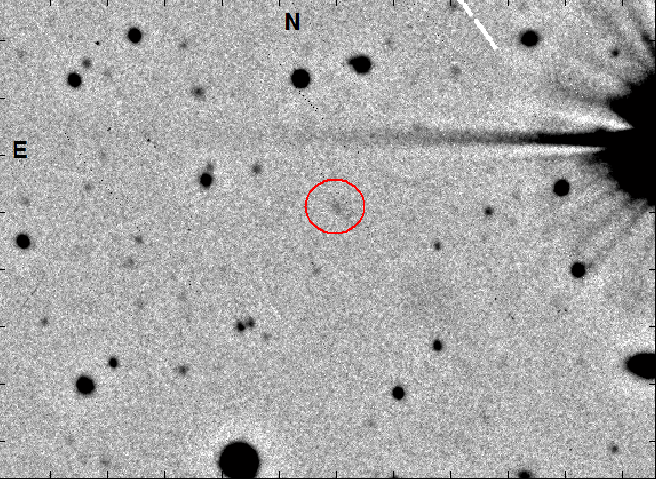
- GCN notice #4085
P. Ferrero, S. Klose, A. Kann, A. Zeh, and B. Stecklum,
Thueringer Landessternwarte Tautenburg,
report:
We have finally analysed the I-band images of the error box of GRB
051008 obtained with the Tautenburg Schmidt telescope. Photometric
calibration was performed using the USNO-B1.0 catalog (Monet et al.
2003).
Two sets of images were taken. The first one consists of six 20 sec
frames (mean time 1.00 hrs after the burst), the second set consists
of six 120 sec frames (mean time 1.25 hrs after the burst). We do not
detect any souce in the XRT error circle (Perri et al., GCN 4073) down
to about I=18.0 and I=18.8, respectively.
Given these I-band upper limits and the deep R upper limit reported by
Rumyantsev et al. (GCN 4081), the afterglow of GRB 051008 is another
example for the general faintness of Swift afterglows compared to
those discovered prior to Swift (cf. Berger et al. 2005, ApJ 629,
328). According to our data archive (Kann et al. 2006, in preparation), there
are 20 afterglows with reliable I-band data
(known light curve parameters alpha_1, alpha_2, and t_break) so that
one can at least extrapolate the light curve to a time period of 1 hr
after the corresponding burst. Among these 20 afterglows at least 18
were brighter than the one of GRB 051008, after correction
for Galactic extinction (GRB 051008 has E(B-V) = 0.01 mag; Schlegel
et al. 1998, ApJ 500, 525).
We note that the very early break time of 0.19 days found in the
X-ray light curve (Perri et al. 2005, GCN 4080) favors a relatively
near-by event when compared with the afterglow sample in the pre-Swift
era. Assuming that this is a jet break, it is earlier than most of
the bursts in the sample of Zeh et al. (2005, astro-ph/0509299). To
equal the earliest jet break in the Zeh et al. sample (GRB 041006:
t_break = 0.14 days in the host frame), the redshift of GRB 051008
must be z < 0.36.
On the other hand, if we use the burst data (fluence & peak energy from
Golenetskii et al., jet break time from Perri et al.) to place the GRB on the
Ghirlanda relation (Ghirlanda et al. 2004, ApJ, 616, 331) using the fit from
Zeh et al. and the typical density parameter n=10 cm^-3 of Friedman & Bloom
2005 (ApJ, 627, 1), low redshifts are highly disfavored, as the high peak
energy is in contrast with the early break and thus a large collimation
correction. A redshift around one is favored.
If the burst was near-by, which could also be indicated by its
high gamma-ray flux and fluence (Golenetskii et al. 2005, GCN 4078),
given the deduced NH column density (Perri et al. 2005, GCN 4080)
host extinction alone cannot explain the faintness of the afterglow
for a gas-to-dust ratio that is close to that of the SMC.
This implies a relatively low-luminosity afterglow. It also implies
the possible appearance of a detectable supernova component
with a peak magnitude brighter than R=21.9 (assuming a SN 1998bw
event).
This message may be quoted.
- GCN notice #4086
A. Pelangeon & J-L. Atteia (LAT-OMP) report:
We have used the spectral parameters of the most intense part
of GRB 051008 provided by Golenetskii et al. (GCNC 4078),
to compute the spectral pseudo-redshift of this GRB.
We find a pseudo-redshift pz= 5.2 +/- 1.3
We thank V. Pal'shin for providing the fluence of this GRB during
the interval extending from T0 to T0+8.192 sec (KONUS time).
This notice can be cited.
- GCN notice #4087
V.Rumyantsev (CrAO), V.Biryukov (SAI, MSU), A.Pozanenko (IKI), M. Ibrahimov
(MAO) on behalf of larger GRB follow up collaboration report:
We reanalyzed the R-band observations of GRB051008 with 2.6m Shajn
telescope of CrAO (Rumyantsev et al., GCN4081). Within XRT error circle
(Perri et al., GCN4073) we found two objects. One object #1 was reported
early in GCN 4081:
RA(J2000) =13 31 29.98
Dec =+42 05 52.06
It is clearly visible in both epochs of observation. Object #2 is apart
6.5" S-W from the object #1, and is not visible in second epoch. The
photometry against of USNO A2.0 (R) is following:
Mid time Exposure object#1 object#2
Oct.8 (UT)
17:14 15x60 s 21.50+/-0.13 22.19+/-0.27
17:37 22x60 s 21.32+/-0.13 >22.6 (3 sigma UL)
We suggest object #2 as an afterglow candidate.
The temporal index estimated from our observations is alpha < -0.5.
Image of the first epoch can be found at
http://grb.rssi.ru/GRB051008/GRB051008_ZTSh_R1.gif
[Correction to GCN 4081: The start of observation on Oct. 8 is 17:05:08
(UT), i.e 32 minutes after the burst onset.]
This message can be cited.

- GCN Circular #4246
D. A. Kann, P. Ferrero, B. Stecklum, S. Klose, Thueringer
Landessternwarte Tautenburg, Germany, report:
The XRT position (Perri et al., GCN 4073) of GRB 051008 (Marshall et
al., GCN 4069, Golenetskii et al., GCN 4078) was reobserved with the
Tautenburg 1.34m Schmidt telescope on October 29, 30 and 31, in good
conditions but near dawn. We obtained 30x60 second Rc-band images in
each epoch. The total exposure of the stacked images is 90 minutes
(meantime 21.5 days after the burst). The flux of the bright star
HD 117710 close to the XRT error circle was carefully removed.
The potential host galaxy (Rumyantsev et al., GCN 4081, 4087) is
clearly detected. At the position of the probable afterglow
(Rumyantsev et al., GCN 4087), no source is detected down to a
limiting magnitude of Rc = 22.5.
Under the assumption that this burst is at a low redshift (Ferrero et
al., GCN 4085), the failure to detect a supernova rebrightening
implies either an underluminous supernova in comparison to SN 1998bw,
which is not unusual (cf. Zeh et al. 2004, ApJ, 609, 952), or a large
amount of source frame extinction, which is indicated by the very high
excess N_H column density along the line of sight (30 times the
Galactic column density, Perri et al., GCN 4080). This situation is
comparable to the bright GRB 051022 for which no afterglow was
detected and a large amount of source frame extinction was implied
from X-ray observations (Butler et al., GCN 4170, and references
therein).
Spectroscopic observations of the putable host galaxy are encouraged.
This message may be cited.
- GCN Circular #4297
M.Ohno, T.Takahashi, Y.Fukazawa (Hiroshima U.),
K.Yamaoka, S.Sugita (Aoyama Gakuin U.),
Y.Terada (RIKEN), K.Abe, Y.Endo, S.Hong, K.Onda,
M.Tashiro (Saitama U.), K.Nakazawa, G.Sato,
T.Takahashi (ISAS/JAXA), R.Miyawaki,
M.Kokubun, K.Makishima (Univ. of Tokyo) and the HXD-II team
The GRB 051008 prompt emission (Swift-BAT trigger #158855;
Marshall et al., GCN 4069, Parsons et al., GCN 4075, Barthelmy et al.,
GCN 4077) triggered Suzaku Wideband All-sky Monitor (WAM),
which covers an energy band of 50 keV - 5 MeV at 16:33:18 UT.
The light curve shows two peaks with total duration about 48.2 sec.
This is consistent with Swift observation (GCN4069).
We performed the time-averaged spectral analysis
using the position information provided by Swift (Marshall et al., GCN 4069).
We found that the emission extends up to at least 2 MeV.
The cutoff power law model provided a good fit.
In the preliminary results, the photon index was 1.24 (+0.13 -0.15)
and the cutoff energy was 1535 (+1419 -561) keV.
The peak flux on 1 sec time scale was 4.1 (+0.3 -0.3) photons/s/cm^2
(100 keV - 2 MeV) and the fluence was 3.2 (+0.2 -0.2)e-5 erg/cm^2
(100 keV - 2 MeV). The errors are at the statistical 90 % confidence level.
Systematic errors, such as the flux calibration uncertainties of
about 20%, are not included in the errors.
You can see the detail information about the instrument of WAM and
the lightcurve in the Web site
http://www.astro.isas.ac.jp/suzaku/research/HXD-WAM/WAM-GRB/grb/grb_table.html
Further analysis and the refinement is in progress.
- GRB 051008: a long, spectrally hard dust-obscured GRB in a Lyman-break galaxy at z ~ 2.8
Volnova et al. 2014, MN 442, 2586
Photometric redshift of host galaxy through strong Ly-break feature at 2.77+0.15-0.20
![]() Previous IAU Circulars
Previous IAU Circulars 






